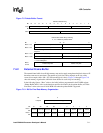
Intel® PXA255 Processor Developer’s Manual 7-13
LCD Controller
Figure 7-10. 16 Bits Per Pixel Data Memory Organization - Passive Mode
)
Note: For passive 16 bits per pixel operation, the Raw Pixel Data must be organized as shown above.
Figure 7-11. 16 Bits Per Pixel Data Memory Organization - Active Mode
)
Note: For active 16 bits per pixel operation, the Raw Pixel Data is sent directly to the LCD panel pins and
must be in the same format as required by the LCD panel.
In dual-panel mode, pixels are presented to two halves of the screen at the same time (upper and
lower). A second DMA channel, input FIFO, and output FIFO exist to support dual-panel
operation. The palette buffer is implemented in DMA channel 0, but not channel 1. The frame
source address for the lower half always points to the top of the encoded pixel values for channel 1.
The frame source address of both DMA channels must be configured such that the least significant
three address bits are all zero (address bits 2 through 0 must be zero). This requires that the source
address of the frame buffer start at 8-byte boundaries.
Each line in the frame buffer must start at a word boundary. For the various pixel sizes, this
requires each line of the display to have pixels in multiples of: 32 pixels for 1-bit pixels, 16 pixels
for 2-bit pixels, 8 pixels for 4-bit pixels, 4 pixels for 8-bit pixels, and 2 pixels for 16-bit pixels. If
the LCD screen does not naturally have the correct multiple of pixels per line, the user must adjust
the start address for each line by adding dummy pixel values to the end of the previous line.
Note: There are two special conditions: 8 bits/pixel monochrome screens with double-pixel-data mode
and 8 or 16 bits/pixel passive color screens require a multiple of 8 pixels for each line.
For example, if the screen being driven is 107 pixels wide, and 4 bits/pixel mode is used, each line
is 107 pixels or nibbles in length (53.5 bytes). The next nearest 8-pixel boundary (for 4-bit pixels)
occurs at 112 pixels or nibbles (56 bytes). Each new line in the frame buffer must start at multiples
of 56 bytes by adding an extra 5 dummy pixels per line (2.5 bytes) to LCCR1[PPL].
If dummy pixels are to be inserted, the panel must ignore the extra pixel clocks at the end of each
line that correspond to the dummy pixels.
Bit 1514131211109876543210
16 bits/pixel
Raw Pixel Data<15:0>
Red Data<4:0> Green Data<5:0> Blue Data<4:0>
Bit 31 16 15 0
Base +
0x0
Pixel 1 Pixel 0
Base +
0x4
Pixel 3 Pixel 2
Bit 1514131211109876543210
16 bits/pixel Raw Pixel Data<15:0>
Bit 31 16 15 0
Base +
0x0
Pixel 1 Pixel 0
Base +
0x4
Pixel 3 Pixel 2


















